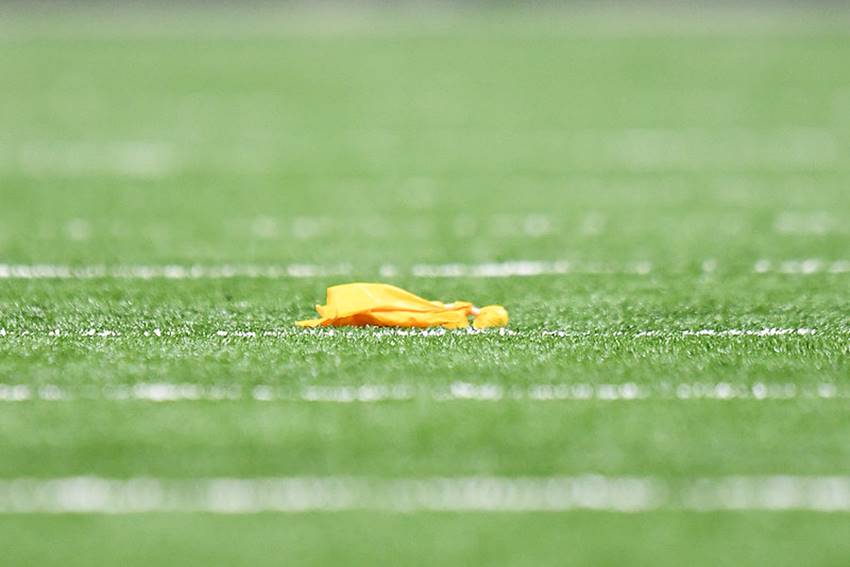Breakdown of duties for NFL game officials

Much like many NFL and college football fanatics, you worry about the quality of officiating. It’s all contingent on human decisions. There is a push to make officials on the NFL level full time. Will that solve all the problems? The human error scenario will always enter into it.
For those ardent fans watching the action, I thought that this may be an opportune time to give you a little history of NFL officiating and explain what their responsibilities entail. They’re not all watching the same thing at the same time. Their duties differentiate.
Every football fan is very aware of the officiating crew at every level. Love ‘em or hate ‘em, without the officials there is no contest. I’m not certain if the average fan knows or understands what the responsibility of each official is.
Here is a little history of the uniform (mostly hats they have worn) and what each one does.
From 1947- 1960, all officials donned white lids during NFL games.
In 1979, slight change, the referee (head official) wore a black cap, all others in the crew wore white caps.
In 1988, a reversal of fashion came when the referee took over the white cap while all of the other crew members wore black.
In 1979, each started to wear a designation on back of the shirt – BJ for back judge, R for referee, LJ line judge, U for umpire, FJ for field judge, HL for head lineman and SJ for side judge.
As for the work that’s done, many times fans have maintained “I could do that job.“ Well, there may be a little more to it than you might think. You will also recognize that there are some overlapping of duties so that more than one official responsible for something.
The umpire is behind the line of scrimmage, 10-12 yards from offensive backfield opposite the referee. He maintains control at line of scrimmage by watching for holding and blocking infractions. He also reviews players’ equipment, counts offensive players on the field and marks off the penalties.
The referee is also in the offensive backfield 10-12 yards off of line of scrimmage. He wears the white cap and oversees everything related to the officiating crew. He maintains the pace of the entire game. He signals all infractions, counts offensive players on the field, watches the ball being snapped and is final authority on any disputed calls. The referee follows the QB until the action moves downfield. He determines whether it is a first down or if a measurement is required. The referee also watches for roughing or running into the kicker.
The back judge is positioned deep in defensive backfield, 25 yards downfield from line of scrimmage. He primarily focuses on the tight end and is responsible for players on end of line. The back judge determines who recovers the fumble and if it is a legal catch or not by the receiver. He counts the defensive players on the field and keeps track of the play clock as well as all television breaks.
Side judges are in the defensive backfield, 20 yards from line of scrimmage towards the same side of the field as the down judge. He watches for pass interference, backs up official clock operator and also serves as primary time keeper if the clock malfunctions. The side judge counts defensive players on the field and signals the referee when time expires at the end of each quarter.
Field judges are in defensive backfield 20 yards behind line of scrimmage, on same side of the field as the line judge. He watches the receiver split widest on near side for illegal use of the hands and any blocking fouls. The field judge also is responsible for penalties in the defensive backfield and watches for pass interference. He counts defensive players on the field and watches the sideline to determine if the runner goes out of bounds.
Down judges are on the opposite side of the field from the line judge, looking directly at the line of scrimmage. He oversees the line of scrimmage and determines the runner’s progress. He also watches for pass interference. The down judge directs the chain crew, watches for offsides and encroachment and rules on sideline plays on the nearest side of the field. He counts the offensive players on the field and informs the referee of the current down.
Line judges, on the opposite side from the down judge, look directly at the line of scrimmage and makes sure the passer does not cross the line of scrimmage. He watches for offsides and encroachment. He also counts offensive players on the field and rules on plays on the near sideline on the nearest half of the field. The line judge watches for any penalties by blockers or defenders on the nearest side of the field.
You’ll notice that there are some carryover duties and double checking by other members of the crew so that one call will be the responsibility of more than one official. So if you’ve qondered ‘how could seven officials miss that call?‘, remember that each has their own area and is not watching the entire field on any given play.
- < PREV Saints by the Numbers: Only garbage time spoils Saints’ stellar defensive effort
- NEXT > Three former LSU players part of this year's World Series teams
Rene Nadeau
CCS/Fox Sports/ESPN/WFAN
Born and raised in the New Orleans area, Rene Nadeau has been involved in sports ever since his earliest memories. Rene played basketball, wrestled, ran track, and was an All-District running back in football at John F. Kennedy High School. He went on to play football at LSU, developing a passion for the game in even greater fashion while in…





